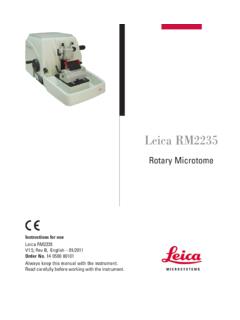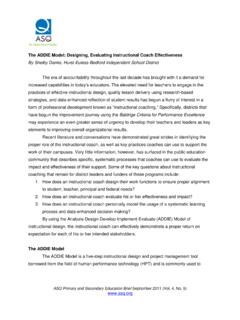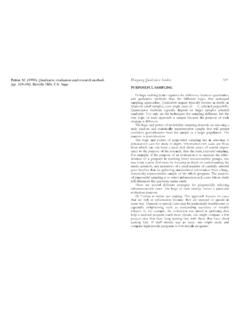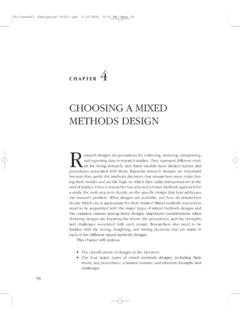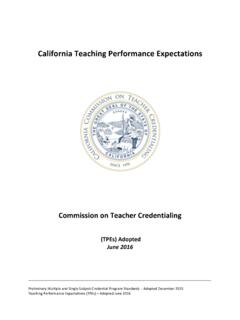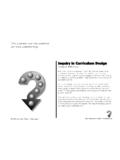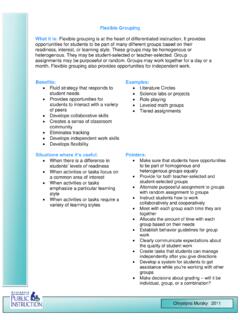Transcription of 4. Designing and validating primers - Research at St ...
1 4. Designing and validating primers DESIGN: When Designing primers , consideration should be given to the area of the target gene being amplified (target sequence) and the thermodynamic properties of the primers themselves. All of these properties factor into the efficiency and specificity of target gene amplification. Forward and reverse primer pairs for qPCR should amplify unique target sequences between 70-150 bp long, that are areas of low secondary structure (GC content < 60%). The primers themselves should follow the guidelines for good primer design, but briefly, their length is typically 15-20 bp long, their GC content should be approximately 50-55% with low secondary structure (hairpins, loops ) but primers should be anchored with a G/C at the 5 end of the sequence and their melting temperature is approximately 5 C higher than the annealing temperature (60 C) in your proposed qPCR run profile (therefore, optimally 65 C).
2 Keep in mind that all the primers used in a single qPCR reaction should have similar annealing/extension temperatures. There are many good on-line sites for primer design: primer BLAST primer 3 IDT SciTools Sample read-out from primer BLAST primer design program IT IS CRITICAL TO BLAST (nucleotide) THE PROPOSED primer SEQUENCE TO ENSURE SPECIFICITY FOR THE TARGET (amplified) GENE. Once your primers arrive, if they are lyophilized, it is recommended to make a 100 uM stock and make a working stock (10 uM) from this. The 100 uM stock should be kept at -20 C and opened only to create new working stocks. This will reduce the possibility of contamination. VALIDATION: It is recommended to purchase the top two predicted primer pairs and perform the validation on both primers .
3 Depending on the availability of your template ( whether your samples are readily obtained from experimental animals or cell culture or whether they are precious human samples) you may wish to validate your primers on a commercially available universal cDNA. For example, for human primers you can validate on Clontech Laboratories Human Universal Reference Total RNA (cat #639653/54). While there may be some variability in your target gene expression between this cDNA and that obtained from your biopsy/sample, it is as good as you can get without wasting your precious samples on validation. Ideally, the multiple primers you will use for qPCR all have a reasonable efficiency at the same annealing/extension temperature (usually 60 C).
4 You will have factored this into the design of the primer by specifying melt temperatures (between 63-68 C) as one of the variables. Before performing a qPCR reaction and using expensive SYBR Master Mix, it is recommended to first check the specificity of your primers by running an endpoint PCR reaction first and running the products on a DNA acrylamide gel. In this reaction, you should include a no-template control (NTC) to test for contamination of your buffers and solutions as well as the prevalence of primer -dimer formation. You should also perform multiple PCR reactions to determine the optimal concentration of primers to use for amplification (usually between 100-500 nM). Sample end-point reaction: (50 ul final volume) 40 ul UPW (ultra pure water) 1 ul forward primer (10 uM stock) 1 ul reverse primer (10 uM stock) 5 ul 10X Taq buffer (which includes MgCl2) 1 ul dNTP mix ( mM stock) 1 ul template (Universal cDNA or target cDNA 10-50 ng/ul stock) (OR WATER, IF A NO-TEMPLATE CONTROL) 1 ul Taq polymerase PCR Parameters: 95oC 2:00 minutes 40 cycles of: 95oC 60 seconds (denature) 60 oC 30 seconds (anneal) 4 oC hold Run products on an acrylamide DNA gel, prepared as follows: ml Ultrapure H2O ml 29:1 Acrylamide:Bis (30%.)
5 Biorad cat# 1610156) ml 50x TAE solution l APS l TEMED Using a SDS-PAGE gel apparatus ( vertical electrophoresis) set up plates and fill entirely with this solution ( , there is no stacking/separating gel). Top with either 10 or 15 well comb. Allow polymerization, remove comb, flush wells with water and load PCR sample with 6X loading buffer (for DNA agarose gels NOT sample buffer for protein gels) diluted to 1X. Load DNA ladder according to predicted size of products. The gel requires 30-45 minutes to run (at 120V). When lower loading dye is of the way down the gel, remove from plates and incubate gel in ethidium bromide bath (250ml H2O with 5 l Ethidium Bromide stock solution (10mg/ml; Invitrogen cat# 15585-011)) for up to 60 minutes and then wash with water for up to 60 minutes.
6 * Figure 2. End-point PCR with reference cDNA to confirm amplicon size (A) Reference cDNA (universal human cDNA) was utilized as template for end-point PCR to verify the ability of primers to amplify a SINGLE amplicon of predicted size as well as no background (*) in cDNA negative control. Once you have confirmed that your primers render a single product with no background and the product migrates at the predicted size, you can use this primer set in a qPCR reaction for melt-curve analysis and generating a standard curve to evaluate PCR efficiency. Initially, try only a few primers ( housekeepers such as GAPDH and HMBS) to get used to the equipment, procedures and pipetting. It s not difficult once you get used to it, but pipetting a full 384 well plate is not trivial for a beginner.
7 It is recommended to use a 6 point standard curve, using 1:5 or 1:10 serial dilutions (in triplicate) of your cDNA template along with NTC and NRT (no reverse transcription) controls, each in triplicate. The total reaction volume per well is 10 l (8 ul master mix plus 2 ul template), following a similar formula for this SAMPLE of master mix calculations: Negativ100bp 1 2 3 4 5 6 7 8 9 *Negative Controls (no cDNA) Reagent [Stock] Volume/rxn samples Master Vol. Final concentration SYBR Green Mix 2x l 21 105 l 1x primer mix (FWD/REV) 10 M l 21 l 400nM ( determined prior) H2O (RNase/DNase free) l 21 l N/A Total: l 168 l For serial template (cDNA) dilutions: Commercial human cDNA (Clontech cat #636693) or experimental cDNA was serially diluted 1:10 enough for 6 wells (per concentration): 2 l of stock cDNA was diluted in 18 l H2O and then serially in the same manner (6 times) to 1:1,000,000.
8 Each concentration was done in triplicate for each primer 2 l of the cDNA was dispensed into each well. Of note, when dispensing into the microplate, the pipette tip should be placed on the side of the well: the plate will be spun to bring everything together. This is a SAMPLE of what the 384 well plate will look like. Master mix and template are dispensed with a repeat electronic pipettor (for accuracy) into a 384-well plate. Once the plate is loaded, it must be sealed with an optical cover (ABI 4311971) to prevent evaporative loss. Spin the plate for 2 minutes at 1200rpm and then run the qPCR reaction. The melt-curve performed at the end of the qPCR cycles is important in confirming the specificity of the primer annealing.
9 The curve should display a single peak with no shouldering (see below). The standard curve is used to calculate the efficiency of the qPCR reaction, or how well the polymerase is able to amplify the target cDNA given the primer sequences and the reaction conditions. In a perfectly efficient (100%) reaction, there is a product doubling every cycle, but reaction efficiencies can be either higher or lower than 100% due to inhibitory factors in the cDNA preparation, ineffective primer binding, secondary structure in the target gene, amplicon or primers , old reagents and enzyme or sub-optimal annealing/extension temperatures. The standard curve will also inform you of the optimal template concentration to use so that your target genes amplify within the optimal range (Ct 18-25).
10 Slope: Y-inter: R2 Eff%: The efficiency is calculated by plotting the template quantity vs. the Ct value. The slope of the (linear regression) best fit line reflects the efficiency of the reaction. The reaction efficiency, should always be between 90-110% and it is important that the efficiencies of all the primers used in the qPCR reaction are approximately equal for accurate comparison. The R2 value represents how well the data fit the regression line or whether the efficiencies are different at any point in the range of template concentrations. This R2 value should be as close to as possible with an acceptable range between If the value is significantly lower, check the variability between your technical replicates and discard any data points that fall outside of Ct of each other.
